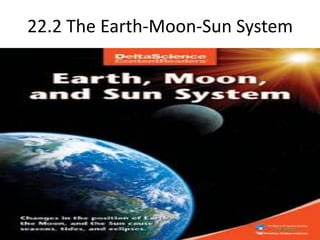Earth science 22.2
•Transferir como PPTX, PDF•
3 gostaram•662 visualizações
Denunciar
Compartilhar
Denunciar
Compartilhar

Mais conteúdo relacionado
Mais procurados
Mais procurados (20)
Destaque
Destaque (7)
Semelhante a Earth science 22.2
Semelhante a Earth science 22.2 (20)
Chapter 23 section 2 notes (the moon earth's satellite)

Chapter 23 section 2 notes (the moon earth's satellite)
Mais de Tamara
Mais de Tamara (20)
Earth science 22.2
- 1. 22.2 The Earth-Moon-Sun System
- 2. Rotation The spinning of a body, such as Earth, about the axis.
- 3. Revolution The motion of one body about another, as Earth about the sun.
- 4. Precession A slow motion of Earth’s axis that traces out a cone over a period of 26,000 years.
- 5. Perihelion The point in the orbit of a planet where it is closest to the sun.
- 6. Aphelion The place in the orbit of a planet where the planet is farthest from the sun.
- 7. Perigee The point at which the moon is closest to Earth.
- 8. Apogee The point where the moon is farthest from Earth.
- 9. Phases of the Moon The progression of changes in the moon’s appearance during the month.
- 10. Solar Eclipse A eclipse of the sun; this occurs when the moon moves in a line directly between Earth and the sun, casting a shadow on Earth.
- 11. Lunar Eclipse An eclipse of the moon; occurs when the moon is in Earth’s shadow.
- 12. Key Concept The two main motions of Earth are rotation and revolution.
- 13. Key Concept Lunar phases are a result of the motion of the moon and the sunlight that is reflected from its surface.
- 14. Key Concept During a new-moon or full-moon phase, the moon’s orbit must cross the plane of the ecliptic for an eclipse to take place.